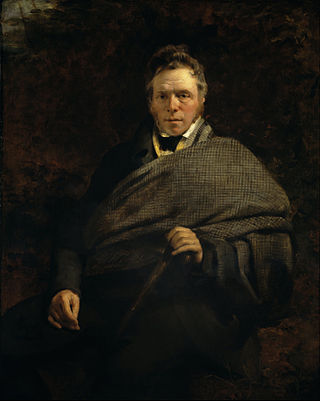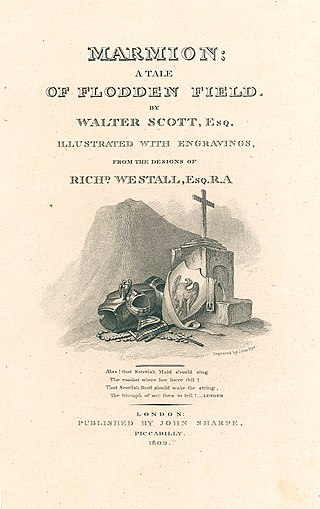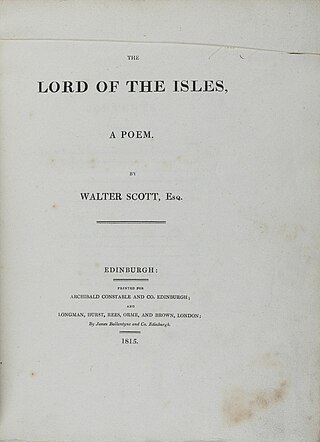Related Research Articles

James Hogg was a Scottish poet, novelist and essayist who wrote in both Scots and English. As a young man he worked as a shepherd and farmhand, and was largely self-educated through reading. He was a friend of many of the great writers of his day, including Sir Walter Scott, of whom he later wrote an unauthorised biography. He became widely known as the "Ettrick Shepherd", a nickname under which some of his works were published, and the character name he was given in the widely read series Noctes Ambrosianae, published in Blackwood's Magazine. He is best known today for his novel The Private Memoirs and Confessions of a Justified Sinner. His other works include the long poem The Queen's Wake (1813), his collection of songs Jacobite Relics (1819), and his two novels The Three Perils of Man (1822), and The Three Perils of Woman (1823).

Thomas Campbell was a Scottish poet. He was a founder and the first President of the Clarence Club and a co-founder of the Literary Association of the Friends of Poland; he was also one of the initiators of a plan to found what became University College London. In 1799 he wrote Pleasures of Hope, a traditional 18th-century didactic poem in heroic couplets. He also produced several patriotic war songs— "Ye Mariners of England", "The Soldier's Dream", "Hohenlinden" and, in 1801, The Battle of the Baltic, but was no less at home in delicate lyrics such as "At Love's Beginning".

Marmion: A Tale of Flodden Field is a historical romance in verse of 16th-century Scotland and England by Sir Walter Scott, published in 1808. Consisting of six cantos, each with an introductory epistle, and copious antiquarian notes, it concludes with the Battle of Flodden in 1513.
Alexander Bald was a Scottish poet.

Percy Bysshe Shelley was a British writer who is considered one of the major English Romantic poets. A radical in his poetry as well as in his political and social views, Shelley did not achieve fame during his lifetime, but recognition of his achievements in poetry grew steadily following his death, and he became an important influence on subsequent generations of poets, including Robert Browning, Algernon Charles Swinburne, Thomas Hardy, and W. B. Yeats. American literary critic Harold Bloom describes him as "a superb craftsman, a lyric poet without rival, and surely one of the most advanced sceptical intellects ever to write a poem."

The Lord of the Isles is a narrative poem by Walter Scott in six cantos with substantial notes. Set in 1307 and 1314 Scotland it covers the story of Robert the Bruce from his return from exile in Ireland to the successful culmination of his struggle to secure Scottish independence from English control at the Battle of Bannockburn. Interwoven with this account is a romantic fiction centring on one of the Bruce's prominent supporters, Ronald, Lord of the Isles, involving his love for the Bruce's sister Isabel, who eventually takes the veil, and the transfer of his affections to Edith of Lorn to whom he had been betrothed at the beginning of the poem and whom he marries at the end.
James Gray was a Scottish educator, poet and linguist. While master of the high school of Dumfries, he became a friend of Robert Burns, later teaching his children. He later held posts at the high school of Edinburgh and the Belfast Academy. He then took orders in the Church of Ireland, serving as a chaplin for the East India Company in Kutch and serving as tutor to the young Rao or Prince of that province, Deshalji II.
The Queen's Wake is a narrative poem by James Hogg, first published in 1813. It consists of an Introduction, three Nights, and a Conclusion, totalling over five thousand lines, and there are also authorial notes. The poem presents the contributions, in various metres, of a series of Scottish bards to a competition organised by Mary, Queen of Scots on her arrival in Scotland from France in 1561.
The Mountain Bard (1807), containing 21 poems, was James Hogg's first substantial poetical publication.
The Forest Minstrel (1810) is an anthology of 83 songs, assembled by James Hogg, divided into four sections: 'Pathetic Songs', 'Love Songs', 'Humorous Songs', and 'National Songs'. Hogg himself is the author of 56 items. There are also 15 by Thomas Mounsey Cunningham, 5 by John Grieve, 3 by William Laidlaw, 3 by James Gray, and one perhaps by John Ballantyne.
The Spy was a periodical directed at the Edinburgh market, edited by James Hogg, with himself as principal contributor, which appeared from 1 September 1810 to 24 August 1811. It combined features of two types of periodical established in the 18th century, the essay periodical and the miscellany. As an outsider, Hogg used his periodical to give a critical view of the dominant upper-class culture of Edinburgh, with Walter Scott and Francis Jeffrey as its leading lights, and to launch his career as a writer of fiction as well as poetry.
Mador of the Moor is a narrative poem by James Hogg, first published in 1816. Consisting of an Introduction, five cantos, and a Conclusion, it runs to more than two thousand lines, mostly in the Spenserian stanza. Set in late medieval Scotland, it tells of the seduction of a young maiden by a charismatic minstrel and her journey to Stirling in search of him, leading to the revelation that he is the king and finally to their marriage and the christening of their son.
Winter Evening Tales is a collection by James Hogg of four novellas, a number of short stories and sketches, and three poems, published in two volumes in 1820. Eleven of the items are reprinted, with varying degrees of revision, from Hogg's periodical The Spy (1810‒11).
Queen Hynde (1825) is an epic poem in six cantos by James Hogg. Set in western Scotland in the sixth century, it tells the story of the defeat of an invading Norwegian army by forces loyal to Queen Hynde, advised by Columba, and of the winning of her hand by the legitimate claimant of the throne Eiden. It is mostly in octosyllabic couplets.
A Queer Book (1832) is a collections of 26 poems, mostly short narratives, by James Hogg, all but two of which had been previously published, more than half of them in Blackwood's Edinburgh Magazine.
Tales of the Wars of Montrose is a set of six fictional narratives by James Hogg published in 1835. Each of them centres on the fortunes of an individual during the civil conflict of the 1640s in Scotland.
The Shepherd's Calendar (1829) is a collection by James Hogg of 21 articles, most of which had appeared in Blackwood's Edinburgh Magazine since 1819. They are set in, or deal with aspects of, the Scottish Borders, in particular Hogg's native Ettrick Forest.
A Series of Lay Sermons is a set of eleven moral and religious discourses by James Hogg published in 1834.
Scottish Pastorals (1801), containing five poems and two songs, was the first book published by James Hogg.
The Brownie of Bodsbeck (1818) is the first (short) novel by James Hogg. Set in the Scottish Borders in 1685 it presents a sympathetic picture of the persecuted Covenanters and a harsh view of the Royalists led by Clavers (Claverhouse). It draws extensively on local superstitions.
References
- ↑ 'Memoir of the Author's Life', in James Hogg, Altrive Tales, ed. Gillian Hughes (Edinburgh, 2003), 35.
- ↑ James Hogg, Midsummer Night Dreams and Related Poems, ed. Jill Rubenstein, Gillian Hughes, and Meiko O'Halloran (Edinburgh, 2008), xiv.
- ↑ Rubenstein, op. cit., 148; Hughes, op. cit., 35‒36.
- ↑ James Hogg, Winter Evening Tales Collected Among the Cottagers in the South of Scotland, ed. Ian Duncan (Edinburgh, 2002), 410‒25.
- ↑ Rubenstein, op. cit., xxiv‒xxvii.
- ↑ Rubenstein, op. cit., xxxii‒xxxv.
- ↑ Hughes, op. cit., 39.
- ↑ For a survey of the reviews, see Rubenstein, op. cit., lxvi‒lxviii.